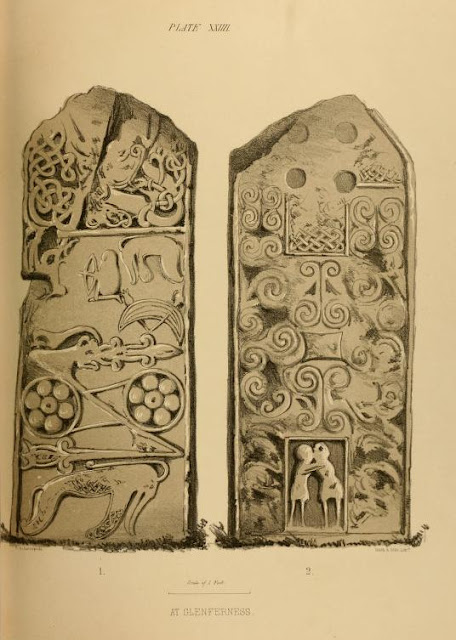The Pictish beastie
The Pictish beastie is one of the most iconic Pictish symbols. But what does it represent? It may be a Kelpie (a water horse of Scottish folklore), a dolphin, an elephant, a horse or a mythical creature. It even looks like a duck billed platypus. However, they are only found in Australia. The Kelpie was a water horse which lived in the rivers, streams and lochs. It would take the form of a human being and lure its victims into the water. However, I don’t think the Pictish beastie represents a Kelpie. It’s positioning on many of the Pictish stones suggests it’s a political or religious symbol. It often appears next to symbols like the double disc and Z rod and the crescent moon and V rod. I thought it looked like a Roman horse brooch. The Picts may have come across these through trade or plunder when raiding Britannia.
 | |||
| Roman horse brooch |
It may also be a hybrid mythical creature worshipped by the Picts. Perhaps a horse and a dolphin? It was common for many cultures to create their own hybrid gods. I also thought the Pictish beastie was a baby animal of some kind. As such, it might be a symbol of royal descent. There are a number of Class II stones which suggest this might be the case. On the St Madoes stone, there are three figures on horseback which may be a father, a mother and a son or daughter. Below the figures, there are three symbols. The Pictish beastie appears below the crescent moon and V rod and the double disc and Z rod.
 |
| The St Madoes stone - John Stuart, Sculptured Stones of Scotland |
On the Dunfallandy stone, there are also three figures. Two figures on thrones which may be a king and queen and a figure on horseback which may be a prince. The Pictish symbols are positioned next to each individual. The queen and the figure on horseback both share the symbol of the Pictish beastie. As the Picts had a matrilineal system of succession, the Dunfallandy stone could be demonstrating this. It could be demonstrating the legitimacy and royal lineage of the figure on horseback. The horseman also has a cross above his head which suggests he has been ordained by the church. The king and the horseman both share the crescent moon and V rod symbol. It may be a symbol of kingship or a royal dynasty.
 |
| The Dunfallandy stone - John Stuart, Sculptured Stones of Scotland |
On the Rodney stone, the Pictish beastie appears
below two sea horses. These may simply be decorative features or they may
suggest that the Pictish beastie is a union of these two sea horses.
 |
| The Rodney stone |
On the Glenferness stone, also known as the Princess stone, there are two figures embracing. On the other side of the stone, there are two symbol pairs – a Pictish beastie and a crescent moon and V rod and a Pictish beastie and a double disc and Z rod. This suggests the stone commemorates two individuals, probably the two individuals embracing. According to a local legend, the stone commemorates a Pictish princess who fell in love with a Viking prince. The Pictish beastie also appears on many Class II stones next to horsemen in hunting scenes etc.
 |
| The Glenferness stone - John Stuart, Sculptured Stones of Scotland |
I think the Pictish beastie is a mythical creature of some
kind which inhabits the rivers, streams and lochs. It may have been dreamed up
by the Picts or their ancestors. In pagan times, they would have worshipped this
creature and provided offerings. Some of the Aboriginal tribes of Australia
worshipped water creatures. For example, the Wadi Wadi tribe worshipped the
duck billed platypus and adopted it as their Totem animal e.g. the spiritual emblem
of their tribe. The Pictish beastie may have also been a symbol of royal
descent. However, these are simply theories.

Comments
Post a Comment